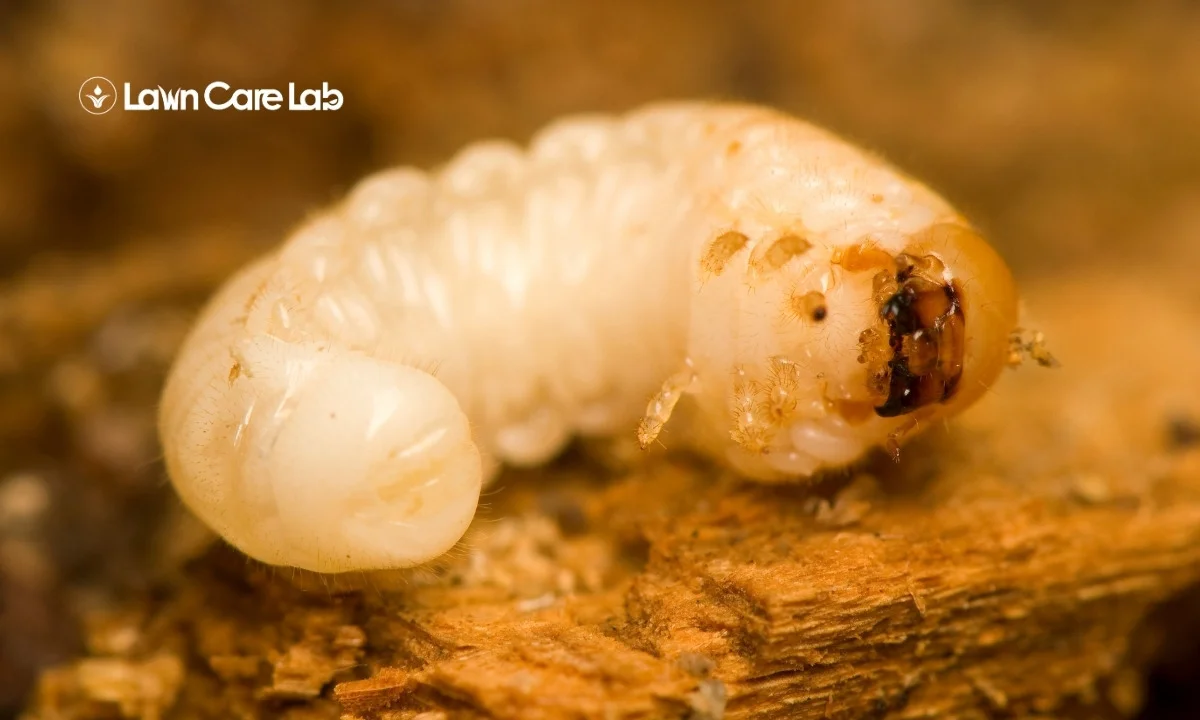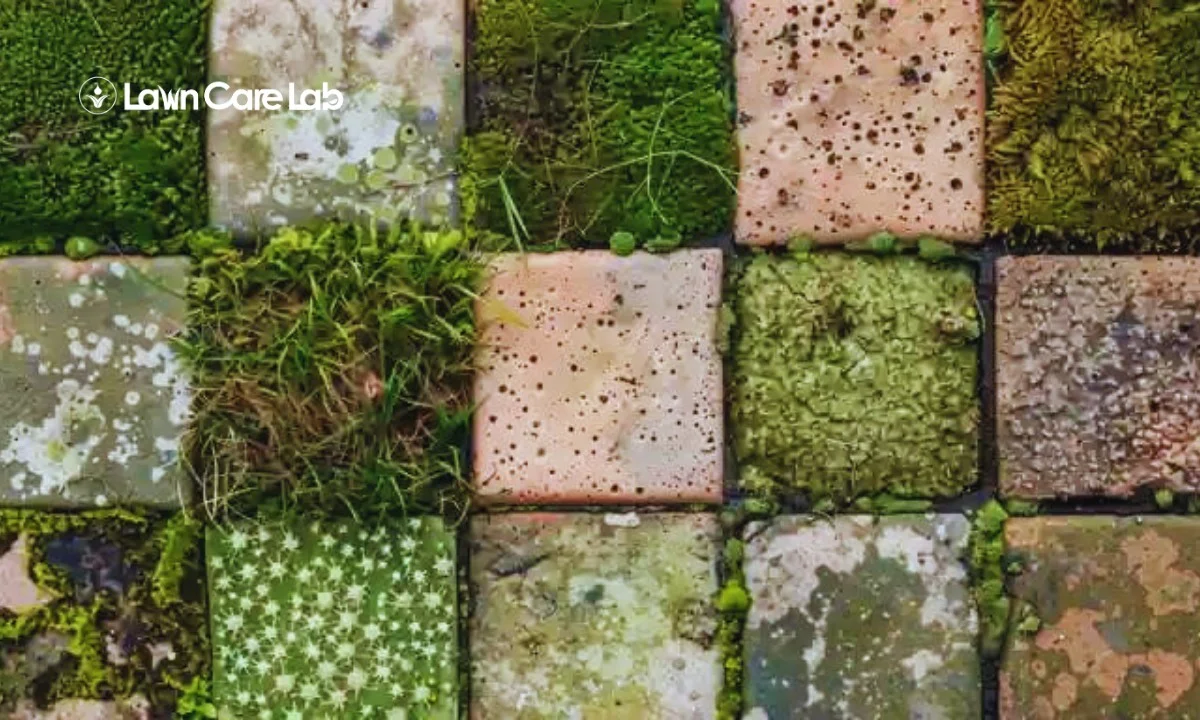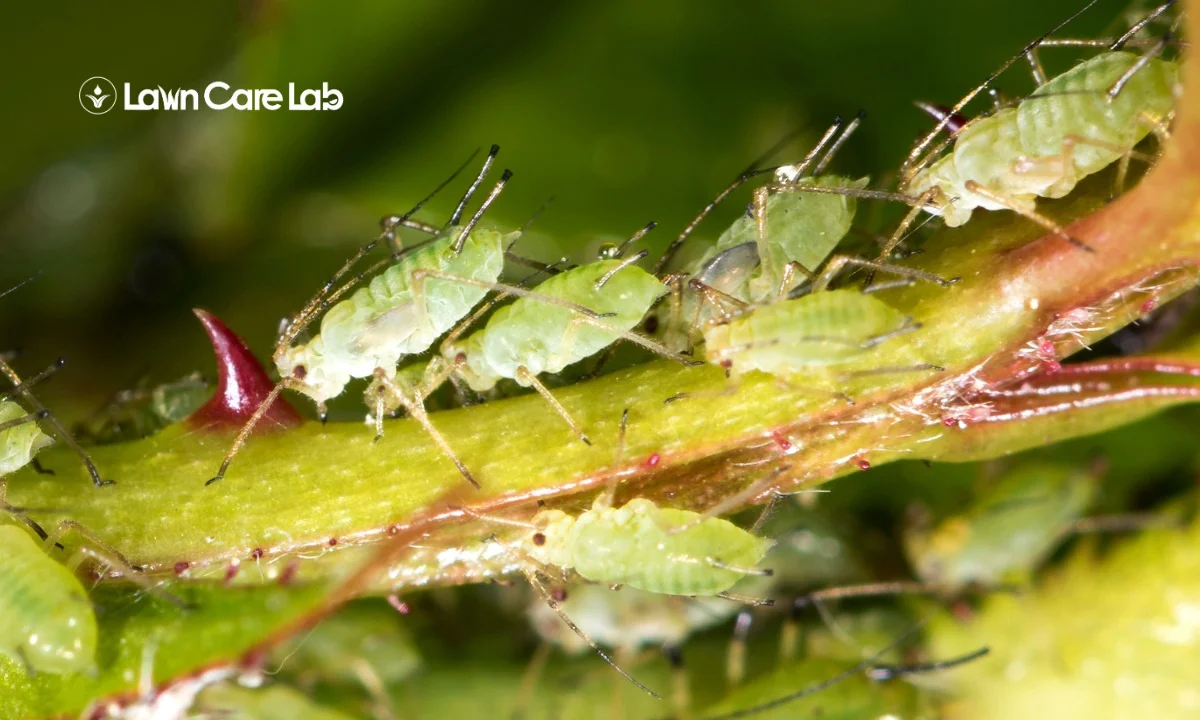Are you fed up with lawn grubs turning your lovely green space into a disaster? You’re not the only one. Lawn grubs are common, but they can be identified and eradicated completely with the correct approach.
It’s time to reclaim your lawn. So, without further ado, let’s tackle this issue head-on, ensuring the safety and aesthetics of your garden.
Are you prepared to become proficient in grub control? Let’s begin our journey.
Table of Contents
Understanding the Grub Invasion
Grubs, those subterranean marauders that wreak havoc on your lawn, aren’t to be trifled with. To effectively manage this menace, you must first become familiar with the telltale signs of their presence.
Following this, a thorough understanding of the specific grub species causing the damage is vital, as the method of control can differ markedly from one species to another.
‘Your lawn is a kingdom, and you’re its guardian. The smallest invaders can cause the greatest damage if left unchecked.’
Recognizing the Signs of a Grub Invasion
Brown patches or more wildlife could mean grubs under your lawn. Look for specific signs.
Here’s a quick guide to help you identify the problem:
| Indicator | Explanation | Preventive Steps |
|---|---|---|
| Discolored Patches | Unusual brown spots appearing on your lawn | Ensure proper watering and inspect for grubs |
| Increased Wildlife | Frequent visits from birds, raccoons, or skunks | Set up wildlife deterrents |
| Fading Grass | Grass appearing thin or wilted despite regular care | Inspect for grubs and maintain watering schedule |
Early detection can prevent further damage and protect your lawn from these destructive invaders.
Identifying Different Types of Lawn Grubs
Different species of grubs, such as Japanese beetles, June beetles, and European chafers, can damage your lawn in distinct ways. Identifying them is crucial to control and eradicate them effectively.
For example, Japanese beetles cause extensive root damage, while June beetles prefer organic matter and take longer to mature. European chafers are resilient and can survive in poor soil conditions.
Understanding their lifecycles and habits is essential to designing and implementing effective grub control strategies and lawn preservation.
Methods of Grub Control
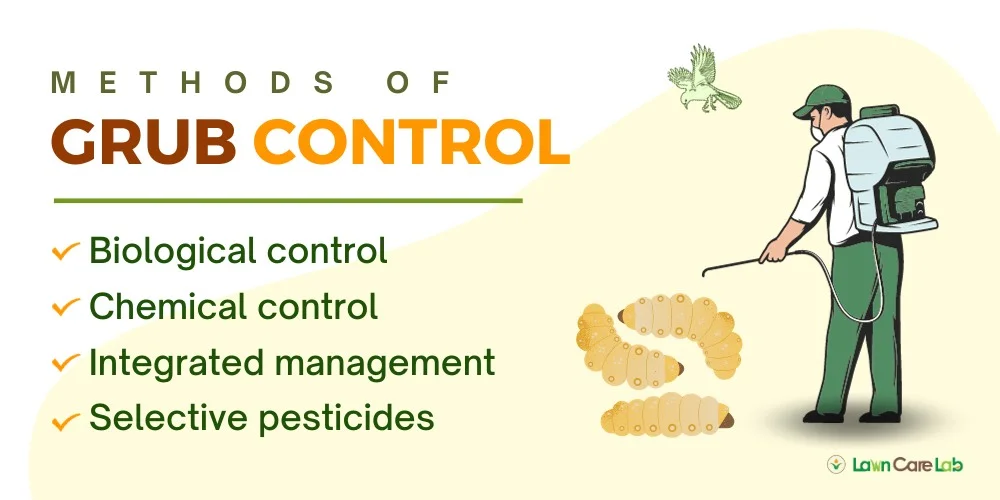
Lawn grubs can damage your lawn’s root system, causing brown patches and plant death. You can control their population by using biological treatments such as beneficial nematodes or chemical treatments like pesticides.
However, excessive use of chemicals can harm beneficial insects and the environment.
Biological and Chemical Control
Use beneficial nematodes – tiny worms that infect and kill grubs when applied to the lawn for a natural approach. You can also attract birds and beetles, natural predators that feed on grubs without any chemicals. While slower, this method is eco-friendly and sustainable.
Use chemical pesticides carefully to get rid of grubs quickly. Choose a product with active ingredients suited to your grub type and infestation level. Follow the manufacturer’s instructions when applying the pesticide, and hydrate your lawn properly. Store chemicals safely and avoid overusing them to protect the environment and beneficial insects.
An integrated pest management plan using biological control and strategic chemical treatment when necessary can keep grubs at bay while minimizing ecological impact. This balanced approach provides effective, lasting solutions for a healthy lawn.
Selecting the Right Pesticide and Application
While pesticides offer fast grub elimination, strategic use is imperative to minimize environmental impact.
Select pesticides like imidacloprid or chlorantraniliprole that target vulnerable grub stages. Ensure registration for your lawn. Follow all label instructions for mixing, dispersing, and dosage.
Measure the infested area precisely. Use calibrated equipment to apply pesticide evenly. Apply when grubs are active. Rehydrate treated areas and store chemicals securely.
Instead of treating the entire lawn, start by targeting smaller areas. Monitor results and resistance before adding more treatments. Rotate chemical classes to avoid using ineffective products.
Pesticides, along with non-chemical methods, can control grub damage while protecting beneficial insects and the ecosystem. Proper knowledge and application are critical.
Maintaining Your Lawn Post Grub Invasion
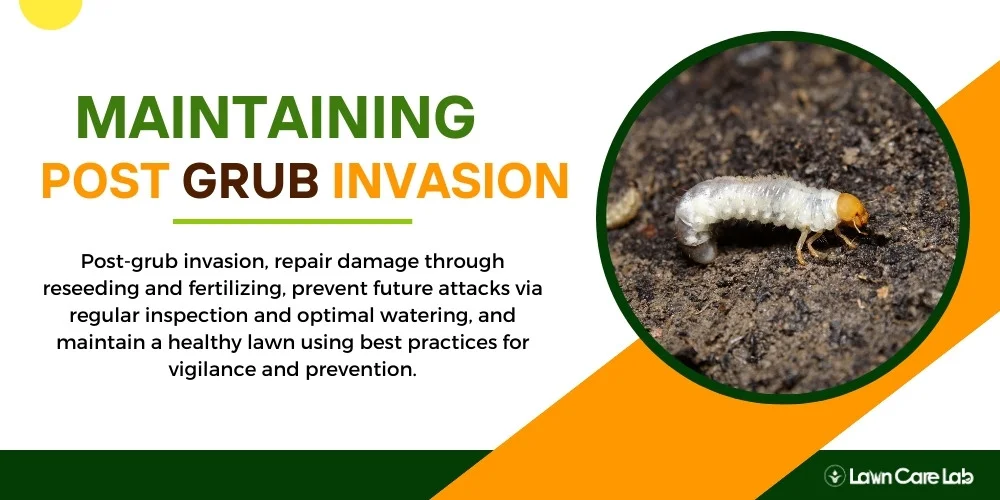
After controlling the grub invasion, revive your lawn’s health and create a prevention plan to protect it from future attacks.
So, let’s start restoring your lawn and fortifying it against potential threats.
Repairing Grub Damage
After successfully warding off unwanted guests, namely lawn grubs, focusing on restoring the impacted green space is essential. The reseeding process becomes indispensable here, filling in the gaps left by these voracious larvae.
A well-chosen fertilizer can act as a catalyst, spurring the growth of new grass and aiding your lawn to regain its lush, verdant status.
Reseeding your Lawn
Post-grub damage, your lawn yearns for a revamp. Here’s your chance to bestow upon it a new lease of life by reseeding the impaired sections.
Success isn’t elusive if you adhere to these simple yet effective guidelines:
- Soil preparation is key
- Opt for premium grass seeds
- Ensure even spread of seeds
- Consistent watering is vital
- Keep a close eye on the growth
Adherence to these guidelines will lead to flourishing a verdant, grub-free lawn sooner than you’d envisage.
Fertilizing for Recovery
While the grubs are gone, and new seeds are sown in your lawn, don’t underestimate the role of fertilization in the recovery process. Opt for a slow-release granular fertilizer to supplement the soil with essential nutrients.
This vital step encourages strong grass growth and helps the lawn regain its former health. A well-timed fertilization strategy can differentiate between a mediocre and a vibrant, lush lawn following a grub infestation.
Preventive Measures for Future Grub Invasions
Regularly checking your lawn for grub activity and adopting proper watering techniques can prevent future infestations. A healthy lawn looks good and discourages pests like grubs from returning.
Regular Lawn Inspection
Your lawn requires consistent attention and care, particularly in the aftermath of a grub invasion. Regular inspection of your lawn aids in its recovery and helps preempt subsequent invasions.
Here are some steps to help you ensure the vitality of your lawn:
- Scan for indications of wilting or unusual color changes.
- Examine the soil to detect any signs of grub presence.
- Pay attention to any unusual increase in bird activity, often a sign of grub infestation.
- Keep an eye on any alterations in lawn texture.
- Make a habit of inspecting your lawn regularly, focusing on the spring and fall seasons when grubs are most active.
As we transition into our next topic, we’ll share some valuable insights on effective watering methods that provide your lawn with additional protection.
Optimal Watering Practices
To keep your lawn healthy, water it adequately. Overwatering can attract pests, leading to infestations. Strike a balance between hydration and saturation to prevent grub invasion. This balanced approach promotes your lawn’s recovery from past grub invasions and fortifies it against future threats.
You’re investing in your lawn’s future using optimal watering techniques.
Using Lawn Rollers for Maintenance
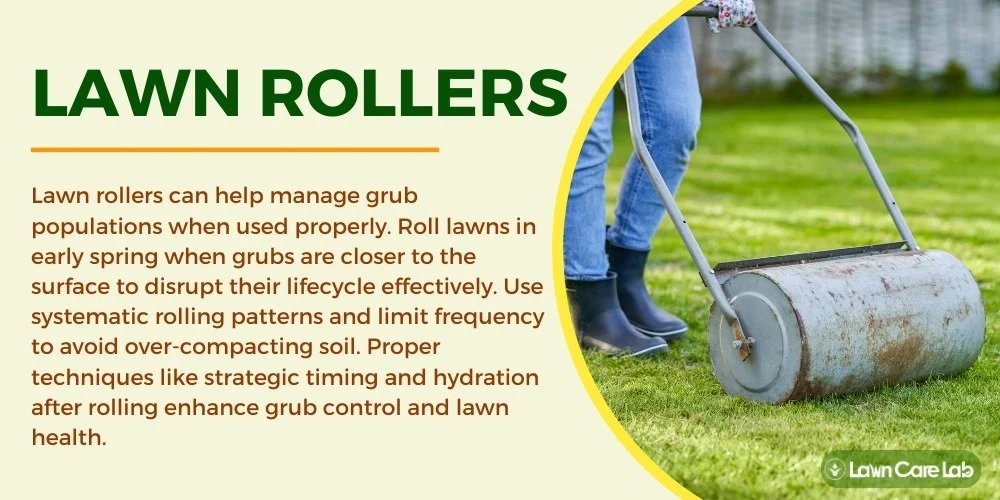
Lawn rollers are not just for aesthetic purposes but can also help manage grub populations.
Regular use of lawn rollers can help you detect early signs of grub infestation and promptly apply insecticides. By learning how to use a lawn roller effectively, you can disrupt the lifecycle of the grubs and transform your lawn into a grub-free green space.
When to Use a Lawn Roller
As the frost melts and spring arrives, it’s time to use your lawn roller. You might wonder why early spring is the best time to do this. The grubs that can damage your lawn are closer to the surface when the soil is still moist.
Rolling your lawn during this period offers manifold benefits:
- Effective grub control: By rolling the lawn when these critters are near the surface, you can effectively control their population.
- Lawn health: Regular rolling can contribute to a verdant, lush lawn your neighbors envy.
- Resource optimization: It’s a smart way to use your gardening resources efficiently.
- Lawn safety: This practice can prevent uneven spots that could potentially damage your lawn or cause accidents.
- Time efficiency: Regular lawn rolling can reduce the time you need to spend on long-term lawn care.
Choosing the right moment to roll your lawn can multiply the fruitfulness of your efforts, leading to a lawn that’s not only free of grubs but beautifully lush.
Proper Lawn Roller Techniques
Rolling in a distinct pattern for effective grub control using lawn rolling and avoiding overpacking the soil is important.
| Method | Purpose |
|---|---|
| Roll systematically | Guarantees no spots are left untreated |
| Limit the frequency of rolling | Avoids soil densification |
| Hydrate post-rolling | Aids in grass root rehabilitation |
An experienced gardener once said, “The art of lawn maintenance isn’t just about the frequency of your care but also the methodology you adopt.”
Hence, knowing these techniques can prove pivotal in your grub control strategy.
Conclusion
Ultimately, the art of grub control depends heavily on grasping the nature of infestations, implementing efficient tactics, and preserving your lawn even after an invasion.
Consider the use of lawn rollers, a transformative tool for lawn upkeep.
It’s not just a matter of eradicating grubs; it’s about fostering a habitat where they find survival difficult.
In the words of a seasoned gardener, ‘Don’t just engage in the skirmish, claim victory in the war against lawn grubs.’
The vitality of your lawn hangs in the balance.
- How Green Spaces Influence Community Interactions - July 8, 2024
- Lawn Fungal Diseases: Identification and Treatment - July 3, 2024
- Lawn Care for All Seasons: A Year-Round Guide for Extreme Climates - June 24, 2024

